Marcia Thornton Jones's Blog, page 135
June 12, 2017
The Doll's Eye: MG Horror at it's Best.
An author friend of mine - Marina Cohen - who writes' MG horror, has recently come out with the perfect summer read for 'tweens: THE DOLL'S EYE.
The Doll’s Eye tells the story of 12 year-old Hadley who, after moving in to a big old house with her new stepfather and stepbrother, finds herself lamenting the loss of her old life. When a lone glass eye rolls out from a dark corner underneath her bed, things begin to change, though not necessarily for the better. A second narrative weaves its way through the novel—that of the first girl who lived in the house and the evil she unwittingly unleashed. It’s a tale of wish fulfillment and consequence, of innocence and happiness. School library journal called it “a must have for horror fans.”
Kirkus review: https://www.kirkusreviews.com/book-reviews/marina-cohen/the-dolls-eye/
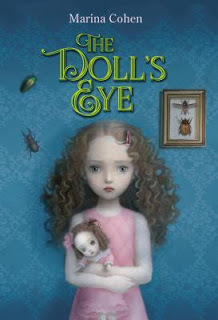 If your kids like spine-tingling creepy tales, they'll definitely enjoy this one.
If your kids like spine-tingling creepy tales, they'll definitely enjoy this one.
The Doll’s Eye tells the story of 12 year-old Hadley who, after moving in to a big old house with her new stepfather and stepbrother, finds herself lamenting the loss of her old life. When a lone glass eye rolls out from a dark corner underneath her bed, things begin to change, though not necessarily for the better. A second narrative weaves its way through the novel—that of the first girl who lived in the house and the evil she unwittingly unleashed. It’s a tale of wish fulfillment and consequence, of innocence and happiness. School library journal called it “a must have for horror fans.”
Kirkus review: https://www.kirkusreviews.com/book-reviews/marina-cohen/the-dolls-eye/
 If your kids like spine-tingling creepy tales, they'll definitely enjoy this one.
If your kids like spine-tingling creepy tales, they'll definitely enjoy this one.
Published on June 12, 2017 07:00
June 11, 2017
June Special Puzzle Edition
from Jody Feldman
 Those who are familiar with my books know that, so far, all the published ones contain puzzles that the main characters must solve in order to achieve some goal. And today, because my mind has drifted back to puzzles as part of my process, I bring you a simple puzzle in honor of Smack Dab’s June and/or Six theme.
Those who are familiar with my books know that, so far, all the published ones contain puzzles that the main characters must solve in order to achieve some goal. And today, because my mind has drifted back to puzzles as part of my process, I bring you a simple puzzle in honor of Smack Dab’s June and/or Six theme.
Changing one letter at a time (and, of course, dropping one along the way) can you morph JUNE into SIX in 6 moves or less?
For example, if I were to ask you to do the same, changing HOG into PIG, the briefest list would include 3 moves: hog - hug - pug - pig.
That’s it from me this month. I’m working hot & heavy on something.
Ooh! How about morphing HOT into HEAVY? I may need to try that soon.
And yep, this is how my puzzle mind works. Taking two pictures or words or thoughts and trying to connect them some way. Which can sometimes be the way I approach plot as well.
By now, you may have guessed that I’m stalling down here because I need to put some space between my puzzle and the answer. So why don’t I just bury my answer to the puzzle in this paragraph? And in my shortest answer, I used five moves to go from June to six: June, tune, tine, sine, sin, six. Your mileage may vary. And now I will just keep typing to further disguise the puzzle answer much like we writers might drop a red herring or context clue or something else in what might appear to be an utterly mundane paragraph so that we mask our spoilers.
The end :)
P.S. Should we morph THE to END as well?
 Those who are familiar with my books know that, so far, all the published ones contain puzzles that the main characters must solve in order to achieve some goal. And today, because my mind has drifted back to puzzles as part of my process, I bring you a simple puzzle in honor of Smack Dab’s June and/or Six theme.
Those who are familiar with my books know that, so far, all the published ones contain puzzles that the main characters must solve in order to achieve some goal. And today, because my mind has drifted back to puzzles as part of my process, I bring you a simple puzzle in honor of Smack Dab’s June and/or Six theme.Changing one letter at a time (and, of course, dropping one along the way) can you morph JUNE into SIX in 6 moves or less?
For example, if I were to ask you to do the same, changing HOG into PIG, the briefest list would include 3 moves: hog - hug - pug - pig.
That’s it from me this month. I’m working hot & heavy on something.
Ooh! How about morphing HOT into HEAVY? I may need to try that soon.
And yep, this is how my puzzle mind works. Taking two pictures or words or thoughts and trying to connect them some way. Which can sometimes be the way I approach plot as well.
By now, you may have guessed that I’m stalling down here because I need to put some space between my puzzle and the answer. So why don’t I just bury my answer to the puzzle in this paragraph? And in my shortest answer, I used five moves to go from June to six: June, tune, tine, sine, sin, six. Your mileage may vary. And now I will just keep typing to further disguise the puzzle answer much like we writers might drop a red herring or context clue or something else in what might appear to be an utterly mundane paragraph so that we mask our spoilers.
The end :)
P.S. Should we morph THE to END as well?
Published on June 11, 2017 06:55
June 10, 2017
Six Reasons to Go To Writing Camp (Otherwise known as a c...
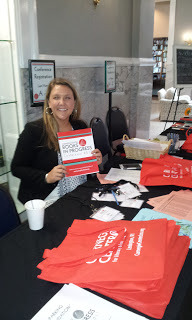 Six Reasons to Go To Writing Camp (Otherwise known as a conference)By Marcia Thornton Jones
Six Reasons to Go To Writing Camp (Otherwise known as a conference)By Marcia Thornton JonesYesterday, while attending The Carnegie Center’s Books-in-Progress Conference, I was chatting with someone about whether or not to invest in a writing program. Was it worth the fee? Was her writing worth it? Was she worth it? The discussion made me wonder: Why are we so hesitant to invest in our own writing? After all, parents are often happy to spend money on summer camps, vacations, and trips to museums for their kids. If parents believe summer camp is worth the investment, why wouldn’t the same be true for us?
As writers, we need to stop feeling guilty about shelling out a few bucks on developing our skills. Conferences, workshops, seminars, and retreats are not indulgences. They’re educational opportunities. So pack your duffel bags because here are six reasons why we as writers should attend a summer camp (otherwise known as a conference).
SIX REASONS FOR WRITERS TO GO TO SUMMER CAMP (OTHERWISE KNOWN AS A CONFERENCE)
Strengthen understanding of craft and technique – No matter how many times I attend a session on a specific topic, I always walk away with new knowledge, insight, and perspective that I can apply to my own work. Attending sessions on voice, plot, and character development helps us take our writing to the next level.Broaden knowledge of marketing and publishing – Participating in an editorial panel of first page critiques, listening to agents talk about market trends, and pitching to agents, editors, and other writers provides insight into the ever-changing world of publishing. Learning about new social media and publishing trends helps us become savvy about marketing our work and ourselves as writers.Challenge creative muscles – Attending sessions that aren’t typically in our wheelhouse provides ah-ha insights for expanding voice and style. For example, a session on memoir writing can help fiction writers learn about character transformation, and signing up for a poetry class can help develop rhythm and imagery in prose.Motivate and inspire – There is an infectious energy at conferences. Discussions, writing prompts, and brainstorming sessions open pathways of discovery and possibility that beg to be applied to works-in-progress when we get home.Develop a community of like-minded colleagues –Having the opportunity to share experiences and develop a sense of community strengthens our sense of purpose and builds self-confidence because we’re reminded that we aren’t the only ones experiencing the highs and lows of trying to put words and stories on the page. Besides…other writers are a lot of fun!Validates our writing and ourselves – Investing in our craft validates and empowers our writing and ourselves as writers to family and friends. It sends a clear message that writing is important not only to us as individuals, but to our communities and culture as well. Besides, if we compared the conference cost to other expenditures (like eating out, glasses of wine over dinner, and chocolate…lots of chocolate) we’d realize that in the grand scope of things, it isn’t that expensive at all.
Simply put, our writing is worth it, and so are we!
See you at camp!
Published on June 10, 2017 06:34
Interview: TWO TRUTHS AND A LIE
Today, we're joined by Ammi-Joan Paquette and Laurie Ann Thompson, the authors of the forthcoming TWO TRUTHS AND A LIE:
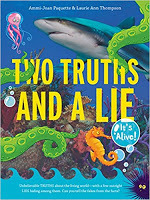 Two Truths and a Lie is the first book in a fascinating new series that presents some of the most crazy-but-true stories about the living world as well as a handful of stories that are too crazy to be true—and asks readers to separate facts from the fakes!
Two Truths and a Lie is the first book in a fascinating new series that presents some of the most crazy-but-true stories about the living world as well as a handful of stories that are too crazy to be true—and asks readers to separate facts from the fakes!
Do the two of you plan to continue your writing collaboration?
LAT: Yes! We have two more TWO TRUTHS AND A LIE titles already in the works, and are hoping we get to do many more. It’s been a blast!
2. The bibliography is quite long and scientific. Who did the research—together? How long did it take?
LAT: We divided up the stories needed for the book and then each researched our own stories. The process was different for every story and the length of time varied. Our amazingly talented copy editors were a huge help along the way, double checking every fact for us and occasionally recommending additional sources. The research is super fun! Formatting bibliographies, however, is less so.
AJP: Spoiler alert—Laurie is way better at formatting bibliographies than I am! All the good stuff you see there is thanks to her. But yes, the research itself has been incredibly interesting. Sometimes we have to forcibly stop ourselves from tunneling out in all the curious and exciting directions that spark off these topics!
3. Laurie, you seem to write non-fiction, while Joan writes fiction. Is this where truth and lies found common ground?
LAT: That was the original plan: I would write the true stories and Joan the false ones, since those were our strengths. We both ended up getting excited about stories on the other side of the fence, however, so in the end it ended up being fairly evenly split.
AJP: It’s been really fun to step outside of our comfort zones a bit and exercise muscles that each of us hadn’t used much before. And I think we have both discovered how much we enjoy doing something that we might not have taken very seriously before. I know I have for sure!
4. You two are located in Seattle and Boston—so how did you handle the writing process?
LAT: Email and Google Docs and Sheets! Technology really facilitates this kind of collaboration, thank goodness. I don’t think being on different coasts hurt us at all.
AJP: Agreed. It’s hard to imagine something like this working in the day of paper mail and long-distance telephone calls. These days though, it’s a breeze—that is, the communication side of things, at least ;)
5. The layout’s fantastic—every page includes something visually intriguing and sure to keep young fingers turning pages. Did you two have any input into the layout / design / illustrations?
LAT: Yes, we had lots of chances to give feedback and input along the way, which was so appreciated. Mostly, though, we just oohed and aahed and applauded the designer’s outstanding efforts! We definitely had a vision of what we wanted it to look like, but she took it to a completely new level.
AJP: It has been very exciting to see the project take shape visually—it adds so many layers and shades of meaning to the stories. This book absolutely could not be without our terrific illustration and design team (not to mention our fabulous editors!). It truly takes a village.
6. This book seems absolutely perfect for classroom discussion. Was that part of the original idea?
LAT: I don’t think it was part of the original idea, but it did come up fairly early on. Our number one goal, however, was making the book entertaining for readers. Any thoughts about classroom applications were secondary. Hopefully we’ve managed to satisfy both without compromising either.
7. In today’s political climate, do you feel that tapping into universal or verifiable truths is more important than ever?
LAT: Yes. We all have to be aware of the difference between fact and opinion. Sometimes our opinions are so strong and heartfelt that they can feel like facts to us. And sometimes we’re not comfortable with the facts as they are, so we chalk them up to opinion or flat out lies. I know I am as guilty of that as the next person, but I try to be aware of and challenge my assumptions in both cases. In this new world of information coming at us from all directions, we all have to learn to ask questions and be careful what we choose to believe and why.
AJP: It really is a whole new world out there, and kids these days are facing questions and dilemmas that we just didn’t have to grapple with as children. It’s our hope that this will be the kind of book that not only entertains but also shows the way to a greater awareness in social consumption, particularly when it comes to all types of media.
8. What do you feel will be the role of juvenile print non-fiction moving forward (especially in the e-age)?
LAT: I think studies are showing that kids prefer paper (at least for now). Other studies have shown that we retain information better when it’s in print (having a definite frame, page numbers, etc.). So, I don’t think nonfiction for kids will be going out of print anytime soon. AJP: Agreed! Paper will always be king in my book J
9. Two truths and a lie:1. Ammi-Joan Paquette wrote a picture book entitled THE TIPTOE GUIDE TO TRACKING FAIRIES.
2. Laurie Ann Thompson has skydived.
3. Laurie and Joan have both found the path to publication to be a completely and total breeze.
(Okay, I'm kind of setting you up here. Our readers love path to publication stories—feel free to tell us yours. The bumpier, the more inspiring.)
AJP: I began seriously writing with an eye toward publication in 2003, and my first kids’ book was published in 2009. Two of my novels—Rules for Ghosting and Princess Juniper of the Hourglass—had 10- and 11-year gaps respectively from the time I began writing them till they were published. Never say never …
LAT: I started writing for kids in 2005. My first book came out in 2014. I don't think anyone would call 9 years a complete and total breeze.
 Two Truths and a Lie is the first book in a fascinating new series that presents some of the most crazy-but-true stories about the living world as well as a handful of stories that are too crazy to be true—and asks readers to separate facts from the fakes!
Two Truths and a Lie is the first book in a fascinating new series that presents some of the most crazy-but-true stories about the living world as well as a handful of stories that are too crazy to be true—and asks readers to separate facts from the fakes!Do the two of you plan to continue your writing collaboration?
LAT: Yes! We have two more TWO TRUTHS AND A LIE titles already in the works, and are hoping we get to do many more. It’s been a blast!
2. The bibliography is quite long and scientific. Who did the research—together? How long did it take?
LAT: We divided up the stories needed for the book and then each researched our own stories. The process was different for every story and the length of time varied. Our amazingly talented copy editors were a huge help along the way, double checking every fact for us and occasionally recommending additional sources. The research is super fun! Formatting bibliographies, however, is less so.
AJP: Spoiler alert—Laurie is way better at formatting bibliographies than I am! All the good stuff you see there is thanks to her. But yes, the research itself has been incredibly interesting. Sometimes we have to forcibly stop ourselves from tunneling out in all the curious and exciting directions that spark off these topics!
3. Laurie, you seem to write non-fiction, while Joan writes fiction. Is this where truth and lies found common ground?
LAT: That was the original plan: I would write the true stories and Joan the false ones, since those were our strengths. We both ended up getting excited about stories on the other side of the fence, however, so in the end it ended up being fairly evenly split.
AJP: It’s been really fun to step outside of our comfort zones a bit and exercise muscles that each of us hadn’t used much before. And I think we have both discovered how much we enjoy doing something that we might not have taken very seriously before. I know I have for sure!
4. You two are located in Seattle and Boston—so how did you handle the writing process?
LAT: Email and Google Docs and Sheets! Technology really facilitates this kind of collaboration, thank goodness. I don’t think being on different coasts hurt us at all.
AJP: Agreed. It’s hard to imagine something like this working in the day of paper mail and long-distance telephone calls. These days though, it’s a breeze—that is, the communication side of things, at least ;)
5. The layout’s fantastic—every page includes something visually intriguing and sure to keep young fingers turning pages. Did you two have any input into the layout / design / illustrations?
LAT: Yes, we had lots of chances to give feedback and input along the way, which was so appreciated. Mostly, though, we just oohed and aahed and applauded the designer’s outstanding efforts! We definitely had a vision of what we wanted it to look like, but she took it to a completely new level.
AJP: It has been very exciting to see the project take shape visually—it adds so many layers and shades of meaning to the stories. This book absolutely could not be without our terrific illustration and design team (not to mention our fabulous editors!). It truly takes a village.
6. This book seems absolutely perfect for classroom discussion. Was that part of the original idea?
LAT: I don’t think it was part of the original idea, but it did come up fairly early on. Our number one goal, however, was making the book entertaining for readers. Any thoughts about classroom applications were secondary. Hopefully we’ve managed to satisfy both without compromising either.
7. In today’s political climate, do you feel that tapping into universal or verifiable truths is more important than ever?
LAT: Yes. We all have to be aware of the difference between fact and opinion. Sometimes our opinions are so strong and heartfelt that they can feel like facts to us. And sometimes we’re not comfortable with the facts as they are, so we chalk them up to opinion or flat out lies. I know I am as guilty of that as the next person, but I try to be aware of and challenge my assumptions in both cases. In this new world of information coming at us from all directions, we all have to learn to ask questions and be careful what we choose to believe and why.
AJP: It really is a whole new world out there, and kids these days are facing questions and dilemmas that we just didn’t have to grapple with as children. It’s our hope that this will be the kind of book that not only entertains but also shows the way to a greater awareness in social consumption, particularly when it comes to all types of media.
8. What do you feel will be the role of juvenile print non-fiction moving forward (especially in the e-age)?
LAT: I think studies are showing that kids prefer paper (at least for now). Other studies have shown that we retain information better when it’s in print (having a definite frame, page numbers, etc.). So, I don’t think nonfiction for kids will be going out of print anytime soon. AJP: Agreed! Paper will always be king in my book J
9. Two truths and a lie:1. Ammi-Joan Paquette wrote a picture book entitled THE TIPTOE GUIDE TO TRACKING FAIRIES.
2. Laurie Ann Thompson has skydived.
3. Laurie and Joan have both found the path to publication to be a completely and total breeze.
(Okay, I'm kind of setting you up here. Our readers love path to publication stories—feel free to tell us yours. The bumpier, the more inspiring.)
AJP: I began seriously writing with an eye toward publication in 2003, and my first kids’ book was published in 2009. Two of my novels—Rules for Ghosting and Princess Juniper of the Hourglass—had 10- and 11-year gaps respectively from the time I began writing them till they were published. Never say never …
LAT: I started writing for kids in 2005. My first book came out in 2014. I don't think anyone would call 9 years a complete and total breeze.
Published on June 10, 2017 02:50
June 8, 2017
Six Stops on a Serendipitous Tour -- by Jane Kelley
Last month we traveled to Turkey. The history, the architecture, the scenery, THE FOOD -- all surpassed our expectations. But as I think back on our Odyssey, some of my favorite adventures were the serendipitous ones.
(The source of that word is also a pleasant surprise. In 1754, Horace Walpole used it in a letter to his friend. He took the word from a Persian fairy tale, The Three Princes of Serendip, whose heroes were "always making discoveries, by accidents and sagacity, of things they were not in quest of.")
We planned to take a ferry from Istanbul up the Bosphorus, until we could glimpse the northern edge of Turkey and the Black Sea.
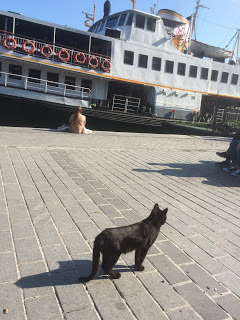 This isn't our cat Blackberry -- just one of the many who live throughout Turkey. On the three hour cruise, we passed Istanbul, palaces, parks, forts and villages. Just before the ferry docked at the last stop, my husband Lee took a photo of what we thought would be our best view of the Black Sea.
This isn't our cat Blackberry -- just one of the many who live throughout Turkey. On the three hour cruise, we passed Istanbul, palaces, parks, forts and villages. Just before the ferry docked at the last stop, my husband Lee took a photo of what we thought would be our best view of the Black Sea.
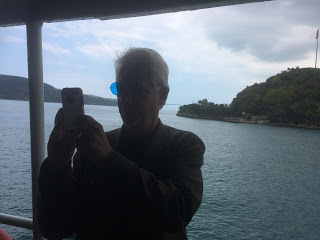
We got off the ferry at the village of Anadolu Kavağı. We would have two hours there before the ferry returned to Istanbul.
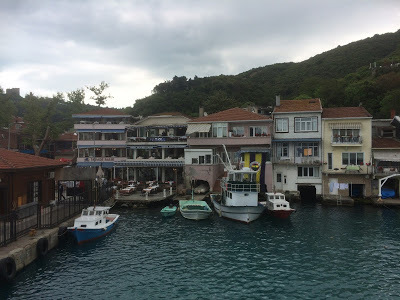
We planned to eat at one of the fancy restaurants that overlooked the harbor. But wait -- what was that ruined tower at the top of that cliff? Could we climb up there? And if so, what would we see?
We hurried past the waiters who shepherded us to their tables and climbed the winding cobblestone streets. A sign said "Kale" -- the Turkish word for castle. But we had no guidance after that until a group of dogs barked fiercely at us. Don't go this way! We were startled because most of the animals we encountered in Turkey were friendly. So we reluctantly turned around––and after a few blocks discovered the correct street that led up and up and up to the castle on the bluff.

Yoros Castle was built in the 13th century. This strategic site was fought over by Byzantine, Ottoman, Genoese, and Cossacks. In present day, the Turkish military has a post near by.

The view of the Black Sea was stupendous. And afterwards, just below the castle, there was even a lovely place to have çay and menemen (tea and tomatoed eggs).

Truly a discovery made by accident, sagacity, and most importantly our desire for adventure.
How many times have you diverged from your writing plan and discovered the place you meant to be all along?
(The source of that word is also a pleasant surprise. In 1754, Horace Walpole used it in a letter to his friend. He took the word from a Persian fairy tale, The Three Princes of Serendip, whose heroes were "always making discoveries, by accidents and sagacity, of things they were not in quest of.")
We planned to take a ferry from Istanbul up the Bosphorus, until we could glimpse the northern edge of Turkey and the Black Sea.
 This isn't our cat Blackberry -- just one of the many who live throughout Turkey. On the three hour cruise, we passed Istanbul, palaces, parks, forts and villages. Just before the ferry docked at the last stop, my husband Lee took a photo of what we thought would be our best view of the Black Sea.
This isn't our cat Blackberry -- just one of the many who live throughout Turkey. On the three hour cruise, we passed Istanbul, palaces, parks, forts and villages. Just before the ferry docked at the last stop, my husband Lee took a photo of what we thought would be our best view of the Black Sea.
We got off the ferry at the village of Anadolu Kavağı. We would have two hours there before the ferry returned to Istanbul.

We planned to eat at one of the fancy restaurants that overlooked the harbor. But wait -- what was that ruined tower at the top of that cliff? Could we climb up there? And if so, what would we see?
We hurried past the waiters who shepherded us to their tables and climbed the winding cobblestone streets. A sign said "Kale" -- the Turkish word for castle. But we had no guidance after that until a group of dogs barked fiercely at us. Don't go this way! We were startled because most of the animals we encountered in Turkey were friendly. So we reluctantly turned around––and after a few blocks discovered the correct street that led up and up and up to the castle on the bluff.

Yoros Castle was built in the 13th century. This strategic site was fought over by Byzantine, Ottoman, Genoese, and Cossacks. In present day, the Turkish military has a post near by.

The view of the Black Sea was stupendous. And afterwards, just below the castle, there was even a lovely place to have çay and menemen (tea and tomatoed eggs).

Truly a discovery made by accident, sagacity, and most importantly our desire for adventure.
How many times have you diverged from your writing plan and discovered the place you meant to be all along?
Published on June 08, 2017 03:00
June 5, 2017
Thoughts on Summer by Deborah Lytton
Summer is a gift for a middle grade writer. The season creates so many opportunities to take characters on adventures.
Here are six ideas about summer to consider when outlining your next book:
1. Vacations to visit grandparents or sleep away camps allow for a fish out of water set up as well as less supervision for characters to engage in adventures.
2. Beach and lake settings can give a writer interesting water activities to detail, as well as bringing in very visual and inviting locations.
3. New friends can be made in the summer time, and this gives a writer an effective way to introduce the main character.
4. With no homework, there is more time to explore and more freedom from strict routines and scenes have time to unfold.
5. The 4th of July is a wonderful holiday to explore in writing as it lends itself to picnics, family gatherings and fun activities.
6. There is the impending return to school which sets a natural boundary to the story and gives the writer a place to go, either to write through the return to school and add suspense to the third act or to draw the story to a close before the first day of school.
What thoughts do you have about writing a story set in the summertime?
Here are six ideas about summer to consider when outlining your next book:
1. Vacations to visit grandparents or sleep away camps allow for a fish out of water set up as well as less supervision for characters to engage in adventures.
2. Beach and lake settings can give a writer interesting water activities to detail, as well as bringing in very visual and inviting locations.
3. New friends can be made in the summer time, and this gives a writer an effective way to introduce the main character.
4. With no homework, there is more time to explore and more freedom from strict routines and scenes have time to unfold.
5. The 4th of July is a wonderful holiday to explore in writing as it lends itself to picnics, family gatherings and fun activities.
6. There is the impending return to school which sets a natural boundary to the story and gives the writer a place to go, either to write through the return to school and add suspense to the third act or to draw the story to a close before the first day of school.
What thoughts do you have about writing a story set in the summertime?
Published on June 05, 2017 07:14
June 3, 2017
Six 2017 Must-Read Middle Grade Novels Featuring Animals
 wee me with a miniature pony
wee me with a miniature pony named Cinnamon (and her foal Sugar)I write about all sorts of things, and for all ages. But one thing all my books have in common is... animals.
I love animals!
And as a middle grader, I really loved animals. Horses, in particular. So grown-up-reader-me is pretty much always looking out for middle grade fiction that features animals.
Here are six 2017 titles I am particularly excited about:
 The Unlikely Story of a Pig by Jodi Kendall (coming Oct. 3)
The Unlikely Story of a Pig by Jodi Kendall (coming Oct. 3) Roll by Darcy Miller (now available)
Roll by Darcy Miller (now available)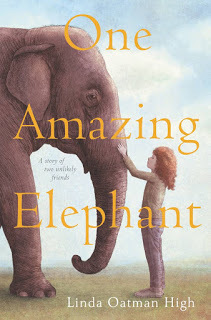 One Amazing Elephant by Linda Oatman High (now available)
One Amazing Elephant by Linda Oatman High (now available) The Dragon with a Chocolate Heart by Stephanie Burgis (now available)
The Dragon with a Chocolate Heart by Stephanie Burgis (now available) A Dog Like Daisy by Kristin O'Donnell Tubb (coming June 13)
A Dog Like Daisy by Kristin O'Donnell Tubb (coming June 13)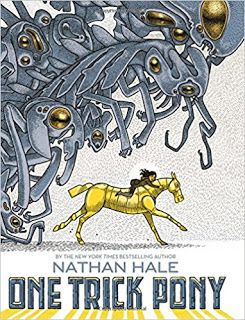 One Trick Pony by Nathan Hale (now available)
One Trick Pony by Nathan Hale (now available)Readers, what 2017 middle grade novels featuring animals are YOU excited about?
----------------------
Irene Latham is the author of more than a dozen current and forthcoming books, including two novels for children: Leaving Gee's Bend (which features a mule named Delilah) and Don't Feed the Boy (which is set at a zoo and features all sorts of animals, including a boy named Whit). irenelatham.com
Published on June 03, 2017 04:00
June 2, 2017
Make Them Feel It By Ann Haywood Leal
Lewis Carroll once said, “What is the use of a book without pictures or conversation?”
 As middle-grade and young adult writers, we owe our readers those pictures and conversation. They are the toughest audience around. Right around third grade, they start to form very strong opinions. When I taught third grade, each day I would get a round of critiques, with their observations, all of their up-and-downs. They watch to see what I have on my desk, what I’ve put around the room, how I might be reacting to the fact that Owen is taking all the razor blades out of the pencil sharpeners, and Anna has brought her cell phone to school and is showing it off in the cubbie room.
As middle-grade and young adult writers, we owe our readers those pictures and conversation. They are the toughest audience around. Right around third grade, they start to form very strong opinions. When I taught third grade, each day I would get a round of critiques, with their observations, all of their up-and-downs. They watch to see what I have on my desk, what I’ve put around the room, how I might be reacting to the fact that Owen is taking all the razor blades out of the pencil sharpeners, and Anna has brought her cell phone to school and is showing it off in the cubbie room.
They see and hear and feel everything. So it is our job to make them see and hear and feel every last bit of our story. We have to provide the pictures and conversation. We have to drop those kids into our book from the first page, from the first sentence, or they are going to turn around and leave. Remember, we’re not there to teach; we’re there to entertain.
They need an equal amount of action, description, and dialogue. Not one word should be there that doesn’t drive the story forward. Give them something to wonder about on the first page. Give them someone to worry about or cheer for. Ray Bradbury reminded us to “find out what your hero or heroine wants, and when he or she wakes up in the morning, just follow him or her all day.” –THEN start your story. Some of that information about your character will never make its way into your book. It will stay inside your head, simmering there as you write. It will, in fact, affect all of your writing, because what you know about your character will come out in bits and pieces with their dialogue, with the way they walk across the room, and the way they interact with the other characters.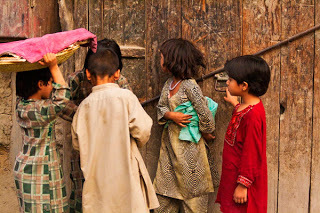
 As middle-grade and young adult writers, we owe our readers those pictures and conversation. They are the toughest audience around. Right around third grade, they start to form very strong opinions. When I taught third grade, each day I would get a round of critiques, with their observations, all of their up-and-downs. They watch to see what I have on my desk, what I’ve put around the room, how I might be reacting to the fact that Owen is taking all the razor blades out of the pencil sharpeners, and Anna has brought her cell phone to school and is showing it off in the cubbie room.
As middle-grade and young adult writers, we owe our readers those pictures and conversation. They are the toughest audience around. Right around third grade, they start to form very strong opinions. When I taught third grade, each day I would get a round of critiques, with their observations, all of their up-and-downs. They watch to see what I have on my desk, what I’ve put around the room, how I might be reacting to the fact that Owen is taking all the razor blades out of the pencil sharpeners, and Anna has brought her cell phone to school and is showing it off in the cubbie room. They see and hear and feel everything. So it is our job to make them see and hear and feel every last bit of our story. We have to provide the pictures and conversation. We have to drop those kids into our book from the first page, from the first sentence, or they are going to turn around and leave. Remember, we’re not there to teach; we’re there to entertain.
They need an equal amount of action, description, and dialogue. Not one word should be there that doesn’t drive the story forward. Give them something to wonder about on the first page. Give them someone to worry about or cheer for. Ray Bradbury reminded us to “find out what your hero or heroine wants, and when he or she wakes up in the morning, just follow him or her all day.” –THEN start your story. Some of that information about your character will never make its way into your book. It will stay inside your head, simmering there as you write. It will, in fact, affect all of your writing, because what you know about your character will come out in bits and pieces with their dialogue, with the way they walk across the room, and the way they interact with the other characters.

Published on June 02, 2017 03:46
May 28, 2017
CELEBRATING BEFORE THE SUCCESS (HOLLY SCHINDLER)
 Memorial Day peonies.So I was taking a picture of our annual peonies, and it suddenly struck me that we never take pictures of a flower bulb. Or seeds. Or dirt in a pot. Or even of a bud about to burst.
Memorial Day peonies.So I was taking a picture of our annual peonies, and it suddenly struck me that we never take pictures of a flower bulb. Or seeds. Or dirt in a pot. Or even of a bud about to burst.We take pictures of the finished product.
Which is also often how we treat any work in progress. We don't celebrate it--not until it's also a finished product.
We celbrate completion. Success. We celebrate the journey after we know the hard work has paid off.
This holiday weekend, though, I want to take a moment to celebrate before the success.
For everyone out there who has taken the plunge, who is writing and doesn't know if anyone will ever want to publish their work--keep watering. Keep the sunlight coming in. Doubt is acidic--nothing can grow there.
You'll get where you want to go. But only if you keep at it, keep at it, keep at it.
And from here on out, be sure to celebrate every little step along the way.
Published on May 28, 2017 05:00
May 22, 2017
Duke Kahanomoku by Laurie Calkhoven
In this month of fives, I'm celebrating my FIFTH book for Simon Spotlight's YOU SHOULD MEET series.
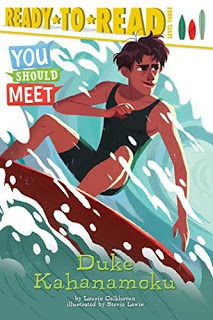 Duke was a full blooded Hawaiian who grew up on the beach. He took part in four Olympics and broke world records in swimming in 1912 and 1920. Along the way he showed the east coast and Australia what surfing was and became the "Father of Modern Surfing."
Duke was a full blooded Hawaiian who grew up on the beach. He took part in four Olympics and broke world records in swimming in 1912 and 1920. Along the way he showed the east coast and Australia what surfing was and became the "Father of Modern Surfing."
And I'm on deadline, so that's all folks.
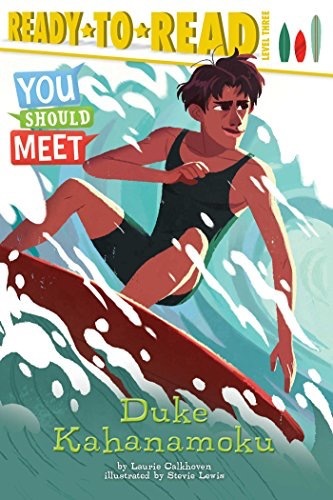
 Duke was a full blooded Hawaiian who grew up on the beach. He took part in four Olympics and broke world records in swimming in 1912 and 1920. Along the way he showed the east coast and Australia what surfing was and became the "Father of Modern Surfing."
Duke was a full blooded Hawaiian who grew up on the beach. He took part in four Olympics and broke world records in swimming in 1912 and 1920. Along the way he showed the east coast and Australia what surfing was and became the "Father of Modern Surfing."And I'm on deadline, so that's all folks.

Published on May 22, 2017 02:30



